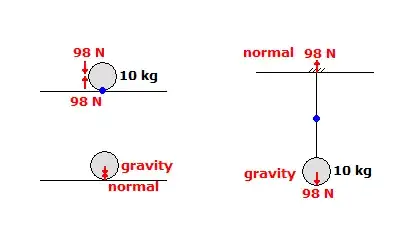I drew 2 diagrams. A 10-kg ball rests on the ground or is suspended from a rope. Everything is in static equilibrium. (I drew the first one twice just to illustrate that the gravity force acts at the center of the ball, and the normal force acts at the contact point.)
Why does the scale read 10 kg at the blue points? Clearly both cases, there are two compressive forces of 98 N, or two tension forces of 98 N. So shouldn't it read 20 kg?
Is it just convention about how are scales are defined? Is it just an arbitrary historical definition? In other words, we defined weight to be whatever the scales read in these situations?
Two more things about this that I feel compelled to state explicitly, to avoid as much confusion as possible.
The two forces illustrated are not Action-Reaction pairs as defined by Newton's 3rd Law. That law says that Action-Reaction acts on two different bodies. (If they both acted on the same body, nothing would ever be able to move). The forces I drew are both acting on the ball, and both acting on the rope, so they cannot be Action-Reaction pairs.
The Normal Force is not a Reaction to Action of gravitational force. The reaction to a gravitational force is another gravitational force. The Earth pulls down the apple, and the apple pulls on the Earth. (diagram link) The reaction to the normal force is another normal force. The surface of the ball pushes on the ground, and the surface of the ground pushes on the ball. The confusion here comes from the word "reaction" because you can use it loosely and ofc the normal force would not be there if gravity did not accelerate the ball towards the ground.
P.S., I've seen the question here. It may be a duplicate but I feel like it's too specific about a case of tension. Mine is more abstract about compression or tension. And ultimately what I'm asking here is if the non-doubling of forces read by a scale is just the arbitrary definition of what scales read.
